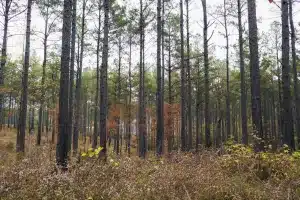Green Star Royalties, the world’s first carbon credit royalty and streaming company boasts funding top-notch North American nature-based climate solutions. It’s a joint venture between Star Royalties Ltd. Agnico Eagle Mines Limited, and Cenovus Energy Inc.
In a recent announcement, Star Royalties, via its partner Green Star, signed a “definitive royalty agreement” with NativState LLC to acquire several gross revenue royalties on a carbon offset-issuing portfolio of Improved Forest Management (IFM) projects in the southeastern United States.
NativState, an Arkansas-based forest carbon project developer, offers small to medium landowners an opportunity to realize the full carbon potential of their forests. They aggregate them into IFM projects registered under the American Carbon Registry (ACR).
Green Star’s Royalty Portfolio: Unlocking the Investment Plan
Green Star expects the royalties to generate high-quality voluntary carbon offsets over 20 years. The total payment of $5.6 million will be made in several installments in U.S. dollars unless specified otherwise.
The key strategies of the investment plan defined by Green Star are:
1. Expanding Green Star’s North American nature-based portfolio:
Acquiring the Royalties on NativState’s IFM projects enhances and broadens Green Star’s existing portfolio of North American nature-based carbon offset solutions.
2. First carbon offset-issuing royalty for Green Star
Green Star’s first carbon offset-issuing investment, Project ACR 783 in Arkansas, is projected to deliver around 180,000 carbon offsets in 2024. It includes approximately 120,000 carbon offsets upon closing. Green Star anticipates that about 75% of its share of carbon offsets from the Royalties will occur within the first five years.
3. Aligned and defensive royalty structure
Green Star and NativState have established defensive mechanisms, including minimum carbon credit volumes to be delivered throughout the 20-year royalty term.
4. Multiple Royalties with strong investment metrics
The Royalties encompass a 20% Royalty on Project ACR 783 and a 10% Royalty on an additional 60,000 acres across Arkansas, Louisiana, Mississippi, and Missouri, slated for development by NativState and registration as future ACR projects. At prevailing carbon offset prices, the Royalties are anticipated to yield significant net present value accretion and offer an attractive payback period.
5. Stable and rising demand for premium North American carbon offsets
Premium North American nature-based carbon offsets are witnessing increasing demand amidst limited supply. Current market pricing for these premium avoidance and removal carbon offsets are approximately $13-15/t CO2e and over $20/t CO2e, respectively.
6. Partnership with a rapidly growing carbon developer
NativState, managing over 300,000 acres, aims to become the largest U.S. aggregator of small-to-medium forest landowners. Green Star is pleased to forge a long-term partnership with NativState, financing American forest landowners eager to engage in both IFM practices and voluntary carbon markets.
Transaction Terms and Impact on Green Star’s Carbon Offset and Revenue Profiles
The transaction immediately provides Green Star with carbon offsets that can be monetized. Over the next 20 years, they’ll keep getting more offsets, with about 75% of them coming in the first five years.

source: Green Star Royalties
However, the transaction terms and conditions are significant for the financial gains of both parties. They include:
- Green Star will acquire the Royalties for $5.6 million, with payments made in installments tied to ACR registration milestones.
- In return for its investment, Green Star will receive a 20% Royalty on Project ACR 783 and a 10% Royalty on an additional 60,000 acres, slated for enrollment by NativState as ACR projects.
- Each Royalty will span a 20-year term starting from the first carbon offset issuance date of the ACR project.
- Carbon offsets will serve as the direct payment method for the Royalties.
- Green Star and NativState have agreed to defensive mechanisms, including minimum carbon offset delivery requirements over the 20-year royalty period.
Enhancing Carbon Sequestration through Improved Forest Management (IFM)
Improved forest management encompasses methods that either reduce emissions from forests or enhance carbon removal and storage. Techniques such as decreasing harvest volumes, extending forest rotations, etc. lower emissions from forests. They generate credits for the curbed emissions.
The conservation plans also elevate carbon storage above the baseline, guaranteeing excellent carbon sequestration.
From an economic perspective,
- These projects achieve increased net carbon stocks by either sequestering carbon through photosynthesis from expanded or maintained forest cover compared to the baseline or by curbing greenhouse gas emissions through reduced timber harvesting.
- Acceptable IFM practices, like extending rotations, implementing thinning, adopting fire prevention methods, and altering harvesting techniques, must comply with the selected carbon registry methodology.
CarbonDirect reports,
“Improved forest management has the potential to increase total stored carbon annually by 200 million to 2.1 billion tonnes without compromising the wood product and ecosystem benefits that come with managed forestlands.”
In the United States, timber harvesting is the most widespread disruption across forested areas, with most of the harvested timber sourced from private lands. Therefore, significant decisions about forest and land management can profoundly impact the capacity of forests to sequester carbon.
Presently, “premium avoidance carbon offsets” in the U.S. market are valued at about $13 to $15 per metric ton of carbon dioxide equivalent (t CO2e), while removal carbon offsets fetch over $20 per t CO2e.
Carbon Offsets and Habitat Protection: The Mission of Project ACR 783
Project ACR 783, also known as the S&J Taylor Forest Carbon Project spreads across 18,000 acres of sustainably managed forestland in Southcentral Arkansas.
Forest project: work in progress

source: NativState
-
Green Star holding a 20% Royalty stake in Project ACR 783, is anticipating to produce ~ 1.5 million carbon offsets over the next two decades.
Notably, Project ACR 783 focuses on maintaining forest carbon stocks through certified and sustainable management practices to achieve significant carbon sequestration in the designated areas.
With its partner NativState, they are aiming to generate sustainable revenue streams through forest management and voluntary carbon markets (VCMs). The latter dedicates itself to conserving valuable hardwoods such as oak, gum, cypress, hickory, and pine forests within the Gulf Coastal Plain eco-region.
Besides carbon revenues, Project ACR 783 will also promote:
- Landscape stability
- Increased biodiversity, and
- Enhanced habitat protection for critical species
Alex Pernin, CEO of Star Royalties, has highly applauded NativState’s approach to the sustainable business model and its carbon offset issuance profile. He noted,
“We are proud to announce this multi-royalty investment in NativState’s portfolio of high-integrity IFM projects in the southeastern United States. This thoughtful transaction transitions Green Star into free cash flow generation and provides desirable economic returns while expanding and diversifying our existing premium North American portfolio.”

